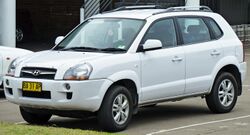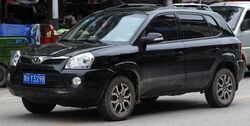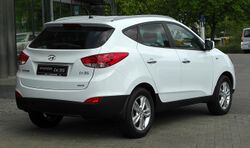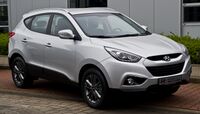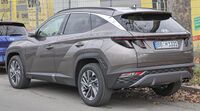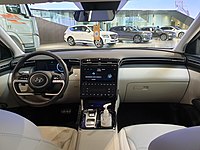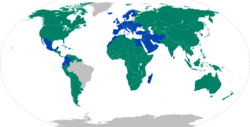Hyundai Tucson
Topic: Engineering
 From HandWiki - Reading time: 27 min
From HandWiki - Reading time: 27 min
| Hyundai Tucson | |
|---|---|
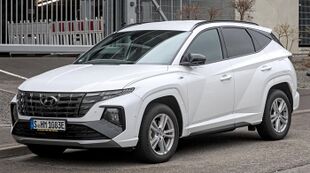 Hyundai Tucson (NX4, SWB) PHEV | |
| Overview | |
| Manufacturer | Hyundai |
| Also called | Hyundai ix35 (2009–2015) |
| Production | 2004–present |
| Model years | 2005–present |
| Body and chassis | |
| Class | Compact crossover SUV (C) |
| Body style | 5-door SUV |
| Layout | Front engine, front-wheel-drive Front engine, all-wheel-drive |
The Hyundai Tucson (Korean: 현대 투싼) (pronounced Tu-són) is a compact crossover SUV[1] produced by the South Korean manufacturer Hyundai since 2004. In the brand's lineup, the Tucson is positioned below the Santa Fe, and above the Kona and Creta. It is named after the city of Tucson, Arizona. The second-generation model was marketed as the Hyundai ix35 in several markets, including Europe, Australia and China, before reverting to Tucson for the third generation. Since its first generation, the Tucson has been developed alongside the Kia Sportage, sharing platforms and engines.
The Tucson is the best-selling Hyundai SUV model, with more than 7 million units sold globally since it launched in 2004. Of these, 1.4 million units have been sold in Europe.[2]
First generation (JM; 2004)
| First generation (JM) | |
|---|---|
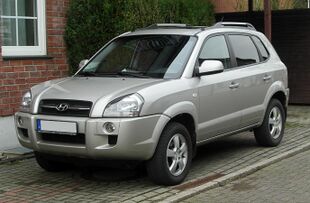 Hyundai Tucson (Germany; pre-facelift) | |
| Overview | |
| Also called | Hyundai JM (Japan) |
| Production | 2004–2009 2005–2019 (Brazil) 2007–2010 (Ukraine) 2005–2010 (Taiwan) |
| Model years | 2005–2009 |
| Assembly |
|
| Body and chassis | |
| Related | |
| Powertrain | |
| Engine | |
| Transmission | |
| Dimensions | |
| Wheelbase | 2,630 mm (103.5 in) |
| Length | 4,325 mm (170.3 in) |
| Width | 1,795 mm (70.7 in) |
| Height | 1,730 mm (68.1 in) |
| us|uk|Kerb|Curb}} weight | 1,470–1,529 kg (3,241–3,371 lb)[3][4][5][6] |
The first-generation Tucson was launched in 2004, after its name was announced in November 2003.[7][8] Positioned as a smaller alternative to the Santa Fe, it shared its Hyundai Elantra-based platform with the second-generation Kia Sportage.[9]
Markets
North America
In the U.S., the Tucson was offered in base GLS, mid-line SE, and top-tier Limited (formerly LX) trim levels for 2007 models. Earlier 2005 and 2006 models were offered as GL/GLS/Limited. Standard equipment included air conditioning, six airbags, electronic stability control, a CD player, alloy wheels, remote keyless entry, and premium cloth seats. The SE added to the roster with contrasting gray body cladding, a different alloy design, an AM/FM/Cassette/CD as well as fog lights and a front windshield wiper de-icing grid. The Limited added leather seating surfaces, a 6-disc in dash CD changer, body-colored cladding, automatic climate control, and heated seats. The GLS and Limited were only available with the 2.7 L V6. The GL came only with the 2.0-litre four-cylinder.
The Tucson offers modest cargo space but its easy-to-fold seats can expand this volume so they lie flat. Even the front passenger seat folds flat for extra-long cargo.
Safety
There are dual-stage frontal impact airbags, torso side-impact airbags built into the front seats, and curtain airbags for side-impact protection for front and rear passengers.
2009 Hyundai Tucson by the U.S. National Highway Traffic Safety Administration (NHTSA)[10]
- Frontal Rating (Driver):





- Frontal Rating (Passenger):





- Side Rating (Driver):





- Side Rating (Passenger):





Model year changes
Changes for 2006 were minimal. The LX became the Limited and got color-coded cladding, automatic climate control, and a high-performance sound system. The GLS retained the gray cladding but 'HYUNDAI' is no longer branded into the cladding on the front doors. The GLS also got improved cloth seats with the option of a heating element. Both GLS and Limited got redesigned alloy wheels. The base GL remained unchanged.
Changes for 2007 were also minimal. The GL and GLS trims were respectively renamed to GLS and SE to match the standard for all new Hyundai vehicles. The SE comes with a sport utility rack, has 4-wheel drive, and is a 6-cylinder engine.
2009 Tucsons saw minor restyling and trim changes.
Tucson FCEV
The Tucson Fuel Cell Electric Vehicle (FCEV) is a test fuel cell vehicle for Hyundai's second-generation hydrogen fuel cell. The vehicle includes an 80 kW electric motor by Enova Systems of Torrance, California, UTC Fuel Cells by South Windsor, Connecticut, 152V battery co-developed by Hyundai Motor Co. and LG Chem in Seoul, Korea, 152 litres (33 imp gal; 40 US gal) hydrogen storage tanks developed by Dynetek Industries of Calgary, Alberta, Canada. The vehicle has range of 300 kilometres (186.4 mi) and top speed of 150 km/h (93 mph).[11]
The vehicle was unveiled at the 2005 Los Angeles Auto Show[12] and completed a 4,300-mile (6,900 km) journey as part of the Hydrogen Road Tour in 2008.[13]
Other markets
In Japan, the Hyundai Tucson was sold as the Hyundai JM until November 2009.[14]
In Brazil, the Hyundai Tucson was produced from October 2009 until the second half of 2018, initially in GL and GLS trim levels - the former available only with a 2.0-litre four-cylinder engine and a choice between a 5-speed manual transmission or a 4-speed automatic transmission, and the latter offering a 2.7-litre V6 engine in addition to the 2.0-litre four-cylinder, both mated exclusively to the 4-speed auto.[15]
A facelifted version of the first generation exclusive to China was produced by Beijing Hyundai. The second generation Tucson was renamed to ix35 in China and Brazil, and later became an independent model while the Tucson name returned with the introduction of the third generation.
Powertrain
| Model | Years | Transmission | Power | Torque | 0–100 km/h (0–62 mph) (official) |
Top speed |
|---|---|---|---|---|---|---|
| Petrol | ||||||
| Beta II 2.0 | 2004–2009 | 5-speed manual | 142 PS (104 kW; 140 hp) @ 6,000 rpm | 18.8 kg⋅m (184 N⋅m; 136 lbf⋅ft) @ 4,500 rpm | 10.4s (FWD) 11.3s (AWD) |
180 km/h (112 mph) (FWD) 174 km/h (108 mph) (AWD) |
| 4-speed automatic | 174 km/h (108 mph) (FWD) | |||||
| Delta 2.7 | 4-speed automatic | 175 PS (129 kW; 173 hp) @ 6,000 rpm | 24.6 kg⋅m (241 N⋅m; 178 lbf⋅ft) @ 4,000 rpm | 10.5s | 180 km/h (112 mph) | |
| Diesel | ||||||
| D 2.0 CRDi | 2004–2009 | 5-speed manual | 113 PS (83 kW; 111 hp) @ 4,000 rpm | 25 kg⋅m (245 N⋅m; 181 lbf⋅ft) @ 1,800–2,500 rpm | 13.1s (FWD) 13.8s (AWD) |
168 km/h (104 mph) |
| 4-speed automatic | 15.1s (FWD) 16.1s (AWD) |
162 km/h (101 mph) | ||||
| 2006–2009 | 6-speed manual | 140 PS (103 kW; 138 hp) @ 4,000 rpm 150 PS (110 kW; 148 hp) @ 4,000 rpm |
31.1 kg⋅m (305 N⋅m; 225 lbf⋅ft) @ 1,800–2,500 rpm | 11.1s (FWD) 12.0s (AWD) |
178 km/h (111 mph) (FWD) 177 km/h (110 mph) (AWD) | |
| 4-speed automatic | 12.8s (FWD) | 175 km/h (109 mph) (FWD) | ||||
Reception
The Hyundai Tucson received accolades from Canadian Car of the Year Best New Crossover award for 2005. It was named as one of the most reliable vehicles from the 2009 Consumer Reports reliability survey.[16]
Safety
The first-generation Tucson in its standard European market configuration received 4 stars for adult occupants, 3 stars for toddlers, and 1 star for pedestrians from Euro NCAP in 2006.[17]
Second generation (LM; 2009)
| Second generation | |
|---|---|
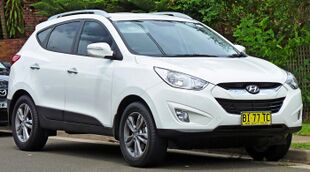 2010 Hyundai ix35 Elite (Australia; pre-facelift) | |
| Overview | |
| Also called | Hyundai ix35 Hyundai Tucson ix |
| Production | 2009–2015 2010–2022 (Brazil)[18][19] |
| Model years | 2010–2015 |
| Assembly |
|
| Designer | |
| Body and chassis | |
| Related | |
| Powertrain | |
| Engine | |
| Transmission | |
| Dimensions | |
| Wheelbase | 2,640 mm (103.9 in) |
| Length | 4,410 mm (173.6 in) |
| Width | 1,820 mm (71.7 in) |
| Height | 1,655–1,685 mm (65.2–66.3 in) |
| us|uk|Kerb|Curb}} weight | 1,410–1,643 kg (3,109–3,622 lb) |
| Chronology | |
| Successor | Hyundai ix35 (NU) (China) |
In most markets outside South Korea and North America, the Hyundai Tucson name (also known as the "Hyundai Tucson ix" in Korea) was retired in favor of Hyundai ix35.[24][25] Vehicles sold in the North America and several other regions continued to be called Tucson.[26] The ix35 was unveiled at the 2009 Frankfurt Motor Show.[27] The power output, fuel-efficiency, comfort and safety features were claimed to have been all upgraded. Known by the project name LM, it took 36 months and 280 billion won (approx. US$225 million) to develop.[28][29]
The ix35's styling was reported to be based on Hyundai ix-onic concept.[30] The ix35 was penned by Hyundai designer Cha Il-Hoei in 2007, under the guidance of former BMW designer Thomas Bürkle at Hyundai's Rüsselsheim design studio in Germany and continues the company's styling language, marketed as "fluidic sculpture".[31][32] The compact crossover vehicle has sweeping coupe-like lines, a premium vehicle feel and comes with features unavailable on its predecessor.
Facelift
The facelifted Tucson was released in South Korea on 2 May 2013, based on the European market ix35 styling with new grille, projector headlights, tail lights, rounded fog lights and front bumper.[33] This facelift was also released in China in August 2013 under the ix35 nameplate, and was not applied in most markets outside South Korea and China, especially in Europe, where only headlights and tail lights were changed,[34] and in North America and Australia, where it retained the pre-facelift styling with only headlights were changed.[35] While in Indonesia, the Tucson received its own facelift in April 2014 based on the global model styling with new grille (similar to the South Korean and Chinese markets), projector headlights, tail lights and fog lights.[36]
Markets
United States
The Tucson sold in the United States came in three trims: GL, GLS and Limited, with All-Wheel Drive available for GLS and Limited trims. The GL comes with a standard manual transmission, but a 6-speed automatic transmission is available and is standard on GLS and Limited. The North American version uses a different gauge cluster design than the Korean version.
The 2011 Tucson offered in the U.S. a new GL trim which replaces the 2010 GLS model as Tucson's base trim. The GL is powered by a new 2.0-litre 4-cylinder engine mated to either a five-speed manual or an available six-speed automatic transmission in order to obtain better fuel economy than the 2.4-litre engine. The 2011 GLS trim includes the features of the 2010 "Popular Equipment Package" and an automatic transmission as standard equipment. Limited models now include standard electrochromatic mirrors with Homelink and has received Sachs dampeners to provide a smoother ride. The electronic stability control and motor driven power steering systems have been enhanced for improved performance. All AWD models now receive standard heated seats.
2014 model Tucson for North America have been upgraded with GDI direct injected Theta II engines that obtain more power and better emissions, LED tail/head lights, more stylish alloy rim designs, and a few minor improvements to the interior/audio system.
Australia
In Australia, the ix35 is available in Active, Elite and Highlander trim levels. The 2.0-litre Theta II petrol engine in front-wheel drive is available on Active and Elite trims, while the 2.4-litre Theta II petrol engine and the 2.0-litre R-series diesel engine are available on Elite and Highlander trims.
Europe
The European market ix35 has a restyled grille, front bumper, rounded fog lights and projector headlights, to differentiate it with global models. This styling was also sold in Malaysia from November 2012 as the Tucson.[37]
In the United Kingdom, the ix35 was initially available in Style and Premium trim levels. It received an update in September 2013 with new headlights and tail lights, and is available in S, SE and Premium trim levels.[38]
China
In China, the first generation Tucson was sold alongside the ix35, which adopted the European market styling, and was replaced by the third-generation Tucson directly while the ix35 spawned its own successor, the Hyundai ix35 (NU). The ix35 NU was revealed on the 2017 Shanghai Auto Show in China and was available to the Chinese car market in the third quarter of 2017.[39]
Powertrain
The Tucson/ix35 is available with several engines: an all-new 2.0-litre diesel R engine, one of two Theta-II petrol engine variants (2.0-litre or 2.4-litre), 1.7-litre UII diesel and 1.6-litre Gamma GDI petrol. The later two only in Europe. The automatic transmission is Hyundai's all-new six-speed design. The manual transmissions available in Europe is a 6-speed for 1.7-litre and 2.0-litre diesels and 1.6 Gamma and a 5-speed for 2.0 Theta. The 2.0-litre diesel engine, available outside of North America, meets the Euro-5 emissions standards and achieves 6.5 l/100 km (15.4 km/L; 36.2 mpg‑US) fuel economy with maximum power output of 184 hp (187 PS; 137 kW). The 2.0-litre petrol engine has a fuel economy of 8.5 l/100 km (11.8 km/L; 27.7 mpg‑US) with 166 hp (168 PS; 124 kW). In South Korea, the diesel engine is offered in both front-wheel drive and all-wheel drive configurations, while the 2.0-litre petrol engine is available only in front-wheel drive.
The North American versions are powered by either the 2.0-litre producing 165 hp (167 PS; 123 kW) or a 2.4-litre four-cylinder petrol engine producing 176 hp (178 PS; 131 kW) mated to the six-speed automatic transmission. The 2.4-litre engine makes almost the same power as the previous generation V6 engine while managing 20% better fuel economy than the previous generation four-cylinder.[40]
| Model | Years | Transmission | Power | Torque | 0–100 km/h (0–62 mph) (official) |
Top speed |
|---|---|---|---|---|---|---|
| Petrol | ||||||
| Gamma II 1.6 GDi | 2009–2015 | 6-speed manual | 135 PS (99 kW; 133 hp) @ 6,300 rpm | 16.7 kg⋅m (164 N⋅m; 121 lbf⋅ft) @ 4,850 rpm | 11.1s | 178 km/h (111 mph) |
| Theta II 2.0 MPi | 5-speed manual | 166 PS (122 kW; 164 hp) @ 6,200 rpm | 20.1 kg⋅m (197 N⋅m; 145 lbf⋅ft) @ 4,600 rpm | 10.4s (FWD) 10.7s (AWD) |
184 km/h (114 mph) (FWD) 182 km/h (113 mph) (AWD) | |
| 6-speed automatic | 10.6s (FWD) 11.2s (AWD) |
182 km/h (113 mph) (FWD) 180 km/h (112 mph) (AWD) | ||||
| Nu 2.0 GDi | 2013–2015 | 6-speed manual | 166 PS (122 kW; 164 hp) @ 6,200 rpm | 20.9 kg⋅m (205 N⋅m; 151 lbf⋅ft) @ 4,000 rpm | 10.4s (FWD) 10.7s (AWD) |
196 km/h (122 mph) (FWD) 195 km/h (121 mph) (AWD) |
| 6-speed automatic | 10.4s (FWD) 11.0s (AWD) |
183 km/h (114 mph) (FWD) 181 km/h (112 mph) (AWD) | ||||
| Theta II 2.4 MPi | 2009–2015 | 6-speed automatic | 177 PS (130 kW; 175 hp) @ 6,000 rpm | 23.1 kg⋅m (227 N⋅m; 167 lbf⋅ft) @ 4,000 rpm | 10.0s | 185 km/h (115 mph) |
| Diesel | ||||||
| U II 1.7 CRDi | 2009–2015 | 6-speed manual | 116 PS (85 kW; 114 hp) @ 4,000 rpm | 26.5 kg⋅m (260 N⋅m; 192 lbf⋅ft) @ 1,250–2,750 rpm | 12.4s | 173 km/h (107 mph) |
| R II 2.0 CRDi | 6-speed manual | 136 PS (100 kW; 134 hp) @ 4,000 rpm | 32 kg⋅m (314 N⋅m; 231 lbf⋅ft) @ 1,800–2,500 rpm | 10.8s (FWD) 11.3s (AWD) |
182 km/h (113 mph) (FWD) 181 km/h (112 mph) (AWD) | |
| 6-speed automatic | 9.8s (AWD) | 195 km/h (121 mph) (AWD) | ||||
| 6-speed manual | 184 PS (135 kW; 181 hp) @ 4,000 rpm | 40 kg⋅m (392 N⋅m; 289 lbf⋅ft) @ 1,800–2,500 rpm | 9.4s (FWD) 10.0s (AWD) |
195 km/h (121 mph) (FWD) 194 km/h (121 mph) (AWD) | ||
| 6-speed automatic | 39 kg⋅m (382 N⋅m; 282 lbf⋅ft) @ 1,800–2,500 rpm | 9.8s (AWD) | 195 km/h (121 mph) (AWD) | |||
Safety
The second-generation Hyundai Tucson earned 'Top Safety Pick' award from Insurance Institute for Highway Safety (IIHS) in the U.S.[41]
| Moderate overlap frontal offset | Good |
| Small overlap frontal offset | Poor |
| Side impact | Good |
| Roof strength | Good |
Third generation (TL; 2015)
| Third generation | |
|---|---|
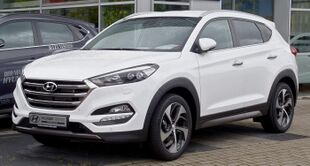 2015 Hyundai Tucson Premium (Germany; pre-facelift) | |
| Overview | |
| Production | 2015–2021 2017–2023 (Brazil) 2016–2022 (India) 2019–present (Pakistan) |
| Model years | 2016–2021 |
| Assembly |
|
| Designer | |
| Body and chassis | |
| Related | |
| Powertrain | |
| Engine | |
| Transmission | |
| Dimensions | |
| Wheelbase | 2,670 mm (105.1 in) |
| Length | 4,475 mm (176.2 in) 4,545 mm (178.9 in) (China) |
| Width | 1,850 mm (72.8 in) |
| Height | 1,645 mm (64.8 in) 1,670 mm (65.7 in) (China) |
| us|uk|Kerb|Curb}} weight | 1,488–1,702 kg (3,280–3,752 lb) |
In February 2015, Hyundai released the first details about its next-generation Tucson ahead of the crossover's official debut at the Geneva Motor Show on 3 March 2015. This model arrived in showrooms in the second half of 2015, as a 2016 model year. Since this generation, Hyundai abolished the ix35 nameplate, reverting to Tucson globally.[51][52][53]
The third-generation Tucson measures 65 mm (2.6 in) longer and 30 mm (1.2 in) wider than its predecessor, while riding on a 30 mm (1.2 in) longer wheelbase. Rear storage space is also larger, with seats-up capacity growing from 465 to 513 litres.
Starting from this generation, safety technologies such as lane departure warning, blind spot detection, and auto braking for pedestrians and cars, along with a dual-clutch automatic transmission and torque vectoring known as Hyundai Active Cornering Control are offered.[54]
Markets
North America
Revealed in April 2015 for the 2016 model year, the North American market Tucson was offered with a choice of two engines, a 2.0-litre direct-injection four-cylinder delivering 164 hp (166 PS; 122 kW) and 151 lb⋅ft (205 N⋅m; 20.9 kg⋅m) of torque with a 6-speed automatic transmission, and a 1.6-litre turbocharged engine with 175 hp (177 PS; 130 kW) and 195 lb⋅ft (264 N⋅m; 27.0 kg⋅m) of torque paired with a 7-speed dual-clutch transmission. Both engines are available in front and all-wheel drive versions.[55] Available in July 2015, the 2016 Hyundai Tucson was available in four trim levels: SE, Eco, Sport and Limited.[56]
Australia
The Tucson was revealed in the country in August 2015. At launch, the Tucson was offered two petrol engines and one diesel, along with 6-speed manual, 6-speed auto and 7-speed dual-clutch auto transmissions. The 2.0-litre petrol engines include the 2.0-litre GDi Nu petrol engine, while it was also offered alongside the older 2.0-litre MPi version of the Nu engine. Other engines offered are the 1.6-litre T-GDi turbocharged petrol engine and a turbocharged 2.0-litre R-Series diesel engine. Models with the 2.0-litre GDi engine were sourced from South Korea, while the 2.0 MPi, 1.6 T-GDi and 2.0 R-Series variants were imported from the Czech Republic.[57][52]
2018 facelift
First shown at the 2018 New York International Auto Show, the Tucson for the 2019 model year received a facelift and significant changes to the powertrain options. Exterior updates included a new cascade grille, reshaped hood and tailgate design, rectangular fuel door, new rim designs, and an updated LED headlight design for higher trim levels. The interior received a major update to include a newly designed dash with lower centrally-placed air vents and a high-mounted head unit display.
In North America, the Driver Attention Warning (DAW) system is standard across all trim levels, and both the Lane Keeping Assist (LKA) departure/correction system and Front Collision Avoidance Assist (FCA) system are now also standard across all trim levels. The manual and dual clutch transmission options were dropped in favor of the 6-speed Shiftronic automatic used in the previous model. The 2.0-litre Nu GDi engine continues in the SE and Value trim levels but for other trims the 1.6-litre I4 turbocharged engine was dropped and replaced by a 2.4-litre I4 GDi naturally aspirated engine which produces 181 hp (184 PS; 135 kW) at 6,000 rpm and 175 lb⋅ft (237 N⋅m; 24.2 kg⋅m) with a slight loss in fuel economy.[58]
In spring 2019, Hyundai started selling the sportier variant N-Line mainly in the European market.[59]
In August 2020, Hyundai Nishat commenced the local assembly of the facelifted model in Pakistan. Initially, it came in only two trim levels, the FWD GLS Sport and the AWD Ultimate. Later on, a third trim level, the FWD GLS, was also launched. All three trim levels come with the 2.0 L Nu MPi I4 engine and 6-speed automatic transmission.[60][61]
2019 Chinese market facelift
For the Chinese market, the Tucson was given an alternate facelift for the 2019 model year with the single model name known as 280TGDi and 6 separate trim levels. The 1.6-litre G4FJ engine is available paired to a 7-speed dual-clutch transmission.[62]
Powertrain
During the Geneva Motor Show, Hyundai also unveiled two concept variants, a Tucson hybrid electric and a diesel-powered plug-in hybrid. The 48V Hybrid combines a 2.0-litre diesel model with 134 hp (100 kW) and a six-speed manual transmission along with a 14 hp (10 kW) electric motor; combined system performance is 148 hp (110 kW) and 413 N·m (305 lb-ft) of torque. This boosts system power by 10% while emitting only 109 g/km CO
2. The concept plug-in-hybrid is also based on the all-new Tucson platform and is equipped with a 1.7-litre diesel engine and a seven-speed dual-clutch transmission. The engine generates 113 hp (85 kW) and is accompanied by a 67 hp (50 kW) electric motor and a 10.7 kWh lithium-ion polymer battery, which delivers an all-electric range of more than 50 km (31 mi). Combined system output is a maximum of 180 hp (135 kW) with 474 N·m (350 lb-ft) of torque, with estimated CO
2 emissions of less than 48 g/km.[63]
| Model | Years | Transmission | Power | Torque | 0–100 km/h (0-62 mph) (official) |
Top speed |
|---|---|---|---|---|---|---|
| Petrol | ||||||
| Gamma II 1.6 GDi | 2015–2020 | 6-speed manual | 132 PS (97 kW; 130 hp) @ 6,300 rpm | 16.4 kg⋅m (161 N⋅m; 119 lbf⋅ft) @ 4,850 rpm | 11.5s | 182 km/h (113 mph) |
| 6-speed automatic | 12.1s | 170 km/h (106 mph) | ||||
| Gamma II 1.6 T-GDi | 6-speed manual | 177 PS (130 kW; 175 hp) @ 5,500 rpm | 27 kg⋅m (265 N⋅m; 195 lbf⋅ft) @ 1,500–4,500 rpm |
|
| |
| 7-speed dual clutch automatic |
|
| ||||
| Nu 2.0 MPi | 6-speed manual | 155 PS (114 kW; 153 hp) @ 6,200 rpm | 19.6 kg⋅m (192 N⋅m; 142 lbf⋅ft) @ 4,000 rpm |
|
| |
| 6-speed automatic |
|
| ||||
| Nu 2.0 GDi | 6-speed automatic | 163 PS (120 kW; 161 hp) @ 6,200 rpm | 20.8 kg⋅m (204 N⋅m; 150 lbf⋅ft) @ 4,500 rpm | |||
| Theta II 2.4 MPi | 6-speed manual | 176 PS (129 kW; 174 hp) @ 6,000 rpm | 23.2 kg⋅m (228 N⋅m; 168 lbf⋅ft) @ 4,000 rpm | |||
| 6-speed automatic | ||||||
| Theta II 2.4 GDi | 6-speed automatic | 184 PS (135 kW; 181 hp) @ 6,000 rpm | 24.2 kg⋅m (237 N⋅m; 175 lbf⋅ft) @ 4,000 rpm | 9.6s | 192 km/h (119 mph) | |
| Diesel | ||||||
| 1.6 Smartstream D1.6 CRDi | 2018–2020 | 6-speed manual | 115 PS (85 kW; 113 hp) @ 4,000 rpm | 28.6 kg⋅m (280 N⋅m; 207 lbf⋅ft) @ 1,500–2,750 rpm | 11.8s | 175 km/h (109 mph) |
| 6-speed manual | 136 PS (100 kW; 134 hp) @ 4,000 rpm | 32.6 kg⋅m (320 N⋅m; 236 lbf⋅ft) @ 2,000–2,250 rpm | 11.2s | 180 km/h (112 mph) | ||
| 7-speed dual clutch automatic | 11.8s | |||||
| 1.7 U II CRDi | 2015–2018 | 6-speed manual | 116 PS (85 kW; 114 hp) @ 4,000 rpm | 28.6 kg⋅m (280 N⋅m; 207 lbf⋅ft) @ 1,250–2,750 rpm | 13.7s | 176 km/h (109 mph) |
| 7-speed dual clutch automatic | 141 PS (104 kW; 139 hp) @ 4,000 rpm | 34.7 kg⋅m (340 N⋅m; 251 lbf⋅ft) @ 1,750–2,500 rpm | 10.6s | 186 km/h (116 mph) | ||
| 2.0 R II CRDi | 2015–2018 | 6-speed manual | 136 PS (100 kW; 134 hp) @ 2,750–4,000 rpm | 38 kg⋅m (373 N⋅m; 275 lbf⋅ft) @ 1,500–2,500 rpm | 10.6s | 187 km/h (116 mph) |
| 2018–2020 | 6-speed manual | 185 PS (136 kW; 182 hp) @ 4,000 rpm | 40.8 kg⋅m (400 N⋅m; 295 lbf⋅ft) @ 1,750–2,750 rpm | 9.9s | 201 km/h (125 mph) | |
| 8-speed automatic | 9.5s | |||||
Safety
Latin NCAP
The Korean-made third-generation Tucson in its most basic Latin American market configuration with 2 airbags, UN127, and no ESC received 0 stars from Latin NCAP in 2021 (similar to Euro NCAP 2014).[65]
Euro NCAP
The third-generation Tucson in its standard European market configuration received 5 stars from Euro NCAP in 2015.[66]
Fourth generation (NX4; 2020)
| Fourth generation | |
|---|---|
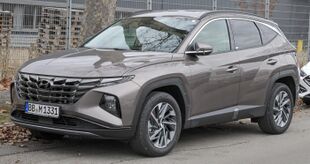 | |
| Overview | |
| Production | 2020–present |
| Model years | 2022–present |
| Assembly |
|
| Designer | |
| Body and chassis | |
| Platform | Hyundai-Kia N3[70] |
| Related | |
| Powertrain | |
| Engine |
|
| Electric motor | Permanent magnet synchronous (hybrid and PHEV) |
| Transmission |
|
| Hybrid drivetrain | 48 V mild hybrid (MHEV) Parallel hybrid (HEV) Plug-in hybrid (PHEV) |
| Battery |
|
| Dimensions | |
| Wheelbase | 2,680 mm (105.5 in) (SWB) 2,755 mm (108.5 in) (LWB) |
| Length | 4,500–4,510 mm (177.2–177.6 in) (SWB) 4,630–4,670 mm (182.3–183.9 in) (LWB) |
| Width | 1,865 mm (73.4 in) |
| Height | 1,650–1,690 mm (65.0–66.5 in) |
| us|uk|Kerb|Curb}} weight | 1,491–1,700 kg (3,287–3,748 lb) |
The fourth-generation Tucson was revealed on 14 September 2020. The all-new model features Hyundai's "jewel-like" grille, with geometric daytime running lights integrated in its design. Hyundai's design team, led by SangYup Lee, its senior vice president and head of Hyundai Global Design Center, has reshaped the Tucson with bulging fenders, angled wheel wells, a level roofline and short overhangs.[72] Prior to its release, the fourth-generation Tucson was previewed as the Vision T Concept showcased at the 2019 Los Angeles Auto Show in November 2019.[73]
Riding on a shortened version of the N3 platform shared with the larger Santa Fe,[74] the fourth-generation Tucson is offered with two wheelbase length for different markets to meet different customers needs and expectations in different regions, which are short-wheelbase (2,680 mm (105.5 in)), and long-wheelbase (2,755 mm (108.5 in)).[75] Most regions outside Europe, Middle East and Mexico receives the long-wheelbase version.[76][77] In China, the long-wheelbase-only fourth-generation Tucson is marketed as the Tucson L to differentiate itself with the older model.[78]
In the interior, the new Tucson features an optional hoodless fully digital instrument cluster and a four-spoke steering wheel. It also includes a vertically stacked, dual 10.25 in (260 mm) full-touch screen with capacitive buttons. For the long-wheelbase version, Hyundai claimed the cargo volume will provide a 38.7 cu ft (1,096 L) of usable space.[75][79]
Facelift (2025)
For the 2025 model year, Hyundai released the facelift version of the fourth-generation Tucson.[80][81]
Markets
Europe
Continued to be produced at Hyundai Motor Manufacturing Czech, the European-market Tucson is solely offered with the short 2,680 mm (105.5 in) wheelbase version. The European range of the fourth-generation Tucson includes five electrified powertrain options, as well as one petrol and one diesel.
The base options are the petrol 1.6-litre T-GDi (turbocharged gasoline direct injection) with 147 hp (149 PS; 110 kW) engine and the diesel 1.6-litre CRDi with 113 hp (115 PS; 84 kW). Both engines are also offered with a mild hybrid 48-volt technology, which include the petrol 1.6-litre T-GDi in 147 hp (149 PS; 110 kW) and 177 hp (179 PS; 132 kW) versions, and the diesel 1.6-litre CRDi with 134 hp (136 PS; 100 kW). Mild hybrid petrol models is fitted with the 6-speed Intelligent Manual Transmission (iMT) as standard.
At launch, the most powerful Tucson is the hybrid 1.6-litre T-GDi HEV, which combines the turbocharged petrol engine with a 59 hp (60 PS; 44 kW) electric motor and a 1.49 kWh lithium-ion polymer battery for a system output of 226 hp (229 PS; 169 kW). The hybrid Tucson will be offered with a 6-speed automatic and optional all-wheel-drive drivetrain. A plug-in hybrid variant based on the 1.6-litre T-GDi petrol with a combined output of 261 hp (265 PS; 195 kW) was introduced in 2021.[82]
North America
The fourth-generation Tucson was revealed for the North American market in November 2020 for the 2022 model year.[83] Offered with the long-wheelbase specification, it features a new 2.5-litre 4-cylinder Smartstream petrol engine rated at 187 hp (190 PS; 139 kW) and 178 lb⋅ft (241 N⋅m; 24.6 kg⋅m) of torque. The Tucson Hybrid is also sold in the region, bringing a combination of 1.6-litre T-GDi engine with a 44 kW electric motor. It is capable of 226 hp (229 PS; 169 kW), 258 lb⋅ft (350 N⋅m; 35.7 kg⋅m) of torque and 30 percent increase in fuel economy. A plug-in hybrid version has also arrived, powered by a 13.8-kWh battery providing 51 km (32 mi) of zero-emission range.[84]
Despite resistance from the labor union in South Korea,[85] Hyundai started to produce the new Tucson in the United States due to its increasing popularity from February 2021.[86] It is produced alongside the Elantra, Sonata and Santa Fe and Santa Cruz in Hyundai Motor Manufacturing Alabama in Montgomery.[87][88]
South Korea
The fourth-generation Tucson was released in South Korea in September 2020. The range includes the 2.5-litre petrol engine, 1.6-litre TGDi petrol, 2.0-litre diesel, 1.6-litre hybrid or 1.6-litre plug-in hybrid.[89]
China
The fourth-generation Tucson was unveiled at the 2020 Guangzhou Motor Show, marketed as the Tucson L. Several exterior changes for the Chinese market include false exhaust tips in the rear.[90] Changes in the interior include a larger vertically mounted touch screen infotainment system.[91] A Smartstream turbocharged engine is offered, which is a 1.5-litre T-GDi engine that produces 197 hp (200 PS; 147 kW), paired with a 7-speed dual-clutch transmission.[92]
Vietnam
The fourth-generation Tucson was introduced in Vietnam on 27 December 2021.[93] It is offered in four grade levels, it uses the 2.0-litre petrol engine paired with 6-speed automatic on Standard and Premium grades, the 2.0-litre diesel engine paired with 8-speed automatic on Premium grade, while the Signature grade gets the Smartstream G 1.6-litre T-GDi engine paired with 7-speed DCT.[94]
Philippines
The fourth-generation Tucson was introduced in the Philippines on 20 June 2022 and it became available on dealerships on 17 August 2022 and is offered in GLS (6-speed automatic) and top-spec GLS+ (8-speed automatic). The 2.0-litre petrol engine is offered for the GLS, while the D 2.0-litre diesel engine is offered for the GLS+ grade.[95][96]
Malaysia
The fourth-generation Tucson was introduced in Malaysia on 10 November 2023.[97] It is offered in three grade levels, the Smartstream G 2.0-litre MPI petrol engine is paired with 6-speed automatic on 2.0 Lite, while the G 1.6-litre T-GDi engine is paired with 7-speed DCT for 1.6T Plus and 1.6T Max.[98]
Powertrain
| Model | Years | Engine | Transmissions | Power | Torque | 0–100 km/h (0-62 mph) (Official) |
Top speed |
|---|---|---|---|---|---|---|---|
| Petrol engines | |||||||
| Smartstream G1.5 T-GDi | 2020–present | 1,497 cc (91.4 cu in) turbocharged I4 | 7-speed DCT | 200 PS (147 kW; 197 hp) @ 6,000 rpm | 25.8 kg⋅m (253 N⋅m; 187 lbf⋅ft) @ 2,200–4,000 rpm | 205 km/h (127 mph) | |
| Smartstream G1.6 T-GDi | 1,598 cc (97.5 cu in) turbocharged I4 | 7-speed DCT | 180 PS (132 kW; 178 hp) @ 5,500 rpm | 27 kg⋅m (265 N⋅m; 195 lbf⋅ft) @ 1,500–4,000 rpm | 8.8s (FWD) 9.0s (AWD) |
201 km/h (125 mph) | |
| Smartstream G2.0 MPi | 2021–present | 1,999 cc (122.0 cu in) I4 | 6-speed manual | 156 PS (115 kW; 154 hp) @ 6,200 rpm | 19.6 kg⋅m (192 N⋅m; 142 lbf⋅ft) @ 4,500 rpm | 10.8s (FWD) 11.1s (AWD) |
186 km/h (116 mph) |
| 6-speed automatic | 11.4s (FWD) 11.6s (AWD) |
181 km/h (112 mph) | |||||
| Smartstream G2.5 GDi | 2,497 cc (152.4 cu in) I4 | 8-speed automatic | 187 PS (138 kW; 184 hp) @ 6,100 rpm | 24.6 kg⋅m (241 N⋅m; 178 lbf⋅ft) @ 4,000 rpm | 9.4s | 197 km/h (122 mph) | |
| Petrol hybrid | |||||||
| Smartstream G1.6 T-GDi 48V | 2020–present | 1,598 cc (97.5 cu in) turbocharged I4 | 6-speed manual 6-speed clutchless manual |
150 PS (110 kW; 148 hp) @ 5,500 rpm | 25.5 kg⋅m (250 N⋅m; 184 lbf⋅ft) @ 1,500–4,000 rpm | 10.3s | 189 km/h (117 mph) |
| 7-speed DCT | 9.6s | ||||||
| Smartstream G1.6 T-GDi Hybrid | 6-speed automatic | 230 PS (169 kW; 227 hp) @ 5,500 rpm | 35.7 kg⋅m (350 N⋅m; 258 lbf⋅ft) @ 1,500–4,400 rpm | 8.0s (FWD) 8.3s (AWD) |
193 km/h (120 mph) | ||
| Smartstream G1.6 T-GDi Plug-in Hybrid | 2021–present | 265 PS (195 kW; 261 hp) @ 5,500 rpm | 8.6s (AWD) | ||||
| Smartstream G2.0 GDi Hybrid | 1,999 cc (122.0 cu in) I4 | 195 PS (143 kW; 192 hp) @ 6,000 rpm | 35.7 kg⋅m (350 N⋅m; 258 lbf⋅ft) | 160 km/h (99 mph) | |||
| Diesel | |||||||
| Smartstream D1.6 CRDi | 2020–present | 1,598 cc (97.5 cu in) turbocharged I4 | 6-speed manual | 115 PS (85 kW; 113 hp) @ 4,000 rpm | 28.6 kg⋅m (280 N⋅m; 207 lbf⋅ft) @ 1,500–2,750 rpm | 12.1s | 175 km/h (109 mph) |
| 7-speed DCT | 136 PS (100 kW; 134 hp) @ 4,000 rpm | 32.6 kg⋅m (320 N⋅m; 236 lbf⋅ft) @ 2,000–2,250 rpm | 11.4s (FWD) 11.6s (AWD) |
180 km/h (112 mph) | |||
| Smartstream D2.0 CRDi | 1,998 cc (121.9 cu in) turbocharged I4 | 8-speed automatic | 186 PS (137 kW; 183 hp) @ 4,000 rpm | 42.5 kg⋅m (417 N⋅m; 307 lbf⋅ft) @ 2,000–2,750 rpm | 9.2s (FWD) 9.4s (AWD) |
201 km/h (125 mph) | |
Safety
The Latin American Tucson has ventilated front disc brakes and solid ones in the rear.[105]
Latin NCAP
The Eurasian-made fourth-generation Tucson in its most basic Latin American configuration with 2 airbags, UN127, and no ESC received 0 stars from Latin NCAP in 2022 (similar to Euro NCAP 2014).[106]
The updated Eurasian-made fourth-generation Tucson in its most basic Latin American configuration with 6 airbags, UN127, ESC, and ISA received 3 stars from Latin NCAP in 2022.[107]
Euro NCAP
The fourth-generation Tucson in its standard European market configuration received 5 stars from Euro NCAP in 2021.[108]
IIHS
The 2022 Tucson was tested by the IIHS and it received a Top Safety Pick+ award:[109]
| Small overlap front (Driver) | Good | ||||
| Small overlap front (Passenger) | Good | ||||
| Moderate overlap front | Good | ||||
| Side (original test) | Good | ||||
| Roof strength | Good | ||||
| Head restraints and seats | Good | ||||
| Headlights |
|
varies by trim/option | |||
| Front crash prevention (Vehicle-to-Vehicle) | Superior | optional | |||
| Front crash prevention (Vehicle-to-Vehicle) | Superior | standard | |||
| Front crash prevention (Vehicle-to-Pedestrian, day) | Superior | optional | |||
| Front crash prevention (Vehicle-to-Pedestrian, day) | Superior | standard | |||
| Seat belt reminders | Acceptable | ||||
| Child seat anchors (LATCH) ease of use | Acceptable |
Sales
| Year | South Korea | U.S.[110][111] | Europe[112][113][114] |
|---|---|---|---|
| 2004 | 7,074 | 17,664 | |
| 2005 | 61,048 | 63,585 | |
| 2006 | 52,067 | 60,500 | |
| 2007 | 41,476 | 53,598 | |
| 2008 | 19,027 | 28,275 | |
| 2009 | 15,411 | 20,485 | |
| 2010 | 39,594 | 53,112 | |
| 2011 | 47,232 | 74,662 | |
| 2012 | 48,878 | 87,963 | |
| 2013 | 41,906 | 88,831 | |
| 2014 | 47,306 | 93,540 | |
| 2015 | 63,591 | 120,358 | |
| 2016 | 56,687 | 89,713 | 158,113 |
| 2017 | 46,382 | 114,735 | 152,875 |
| 2018 | 42,623 | 142,263 | 137,618 |
| 2019 | 36,758 | 137,381 | 136,608 |
| 2020 | 22,179 | 123,657 | 90,594 |
| 2021 | 48,376 | 150,949 | 143,836 |
| 2022 | 32,890 | 175,307 | 150,803 |
| 2023 | 43,744[115] | 209,624 | 133,685[116] |
References
- ↑ Rogers, Cameron (2020-08-25). "Hyundai Tucson Prices, Reviews, and Pictures | Edmunds". https://www.edmunds.com/hyundai/tucson/.
- ↑ "The all-new Hyundai Tucson: a smart tech hero with a standout design" (in en). https://www.hyundai.news/eu/press-kits/the-all-new-hyundai-tucson-a-smart-tech-hero-with-a-standout-design/.
- ↑ "2007 Hyundai Tucson - Specifications - Car Specs - Auto123". https://www.auto123.com/en/new-cars/technical-specs/hyundai/tucson/2007/awd/viva/#mechanical.
- ↑ "2005 Hyundai Tucson - Specifications - Car Specs - Auto123". https://www.auto123.com/en/new-cars/technical-specs/hyundai/tucson/2005/fwd/gl/#dimensions.
- ↑ "2006 Hyundai Tucson - Specifications - Car Specs - Auto123". https://www.auto123.com/en/new-cars/technical-specs/hyundai/tucson/2006/fwd/gl/#dimensions.
- ↑ Carfind.ca. "2007 Hyundai Tucson FWD Specifications - Winnipeg Used Cars, Winnipeg Used Trucks, Manitoba Used Cars, Manitoba Used Trucks, Used Vehicle Reviews, Safety Recalls, Used Cars for Sale in Manitoba". http://www.carfind.ca/en/new/carinfo/specs.spy?used=1&make=Hyundai&model=Tucson+FWD&year=2007.
- ↑ "Hyundai names newest SUV the Tucson". 2003-11-11. https://hyundainews.com/en-us/releases/748.
- ↑ "2004 Hyundai Tucson for sale | AutoTrader.ca". https://www.autotrader.ca/cars/hyundai/tucson/2004/.
- ↑ Kiino, Ron (2005-03-01). "Hyundai Tucson GLS" (in en-US). https://www.caranddriver.com/reviews/a18203288/hyundai-tucson-gls-road-test.
- ↑ 2009 Hyundai Tucson NHTSA Star Rating CarsDirect.com
- ↑ "Hyundai Tucson Hybrid FCEV". Hydrogen-motors.com. 2008-10-21. http://www.hydrogen-motors.com/hyundai-tucson-hybrid-fcev.html.
- ↑ Keegan, Walter J (2005-12-18). "L.A. Auto Show: Hyundai Tucson FCEV". Autoblog.com. http://www.autoblog.com/2005/01/06/l-a-auto-show-hyundai-tucson-fcev/.
- ↑ Abuelsamid, Sam (2008-11-19). "LA 2008: Hyundai announces Blue Drive efficiency strategy, 2010 Sonata hybrid". Green.autoblog.com. http://green.autoblog.com/2008/11/19/la-2008-hyundai-announces-blue-drive-efficiency-strategy-2010?icid=sphere_blogsmith_inpage_autobloggreen.
- ↑ "Hyundai Jm 2.7gls Especificaciones, Dimensiones e Imágenes". https://carfromjapan.com/es/specifications/hyundai/jm/5814340c2afaa2c4b286d736.
- ↑ "Hyundai Tucson sai de linha para dar espaço a SUVs da Caoa Chery". 2018-12-12. https://quatrorodas.abril.com.br/noticias/hyundai-tucson-sai-de-linha-para-dar-espaco-a-suvs-da-caoa-chery/.
- ↑ Consumer Reports' 2009 Annual Car Reliability Survey October 27, 2009. Reuters
- ↑ "Official Hyundai Tucson 2006 safety rating". https://www.euroncap.com/en/results/hyundai/tucson/15698.
- ↑ "Sobre a Hyundai CAOA do Brasil" (in pt). Hyundai CAOA do Brasil. https://hyundai-motor.com.br/sobre-a-hyundai-caoa/.
- ↑ "Hyundai ix35: Histórico e vendas desde 2010 do SUV no Brasil" (in pt-br). https://motor1.uol.com.br/news/570039/historico-vendas-hyundai-ix35-fim/.
- ↑ "Hyundai Tucson now CKD, priced lower from RM116k" (in en-US). 2015-03-18. https://paultan.org/2015/03/18/hyundai-tucson-now-ckd-priced-lower-from-rm116k/.
- ↑ "EUIPO - eSearch". https://oami.europa.eu/eSearch/#details/designs/001603085-0001.
- ↑ Kim, Sung-No, "Passenger car", US patent D715191, published 2014-10-14, assigned to Hyundai Motor Company
- ↑ "Thomas Bürkle". Hyundai Motor UK Ltd.. http://www.hyundaipressoffice.co.uk/page/7/.
- ↑ "First drive: Hyundai ix35". 2010-02-23. https://m.wheels24.co.za/News/General_News/First-drive-Hyundai-ix35-20100223-2.
- ↑ "Hyundai ix35 Unveiled" (in en). https://www.motor1.com/news/17572/hyundai-ix35-unveiled/.
- ↑ Edmunds Used Car Guide, (retrieved 28 July 2015).
- ↑ Abuelsamid, Sam (2009-08-18). "Frankfurt Preview: Hyundai officially teases the new Tucson *UPDATED". Autoblog.com. http://www.autoblog.com/2009/08/18/frankfurt-preview-hyundai-officially-teases-the-new-tucson/.
- ↑ "Hyundai Tucson ix first official images released" (in en). https://www.motor1.com/news/17134/hyundai-tucson-ix-first-official-images-released/.
- ↑ "2010 KDM Hyundai Tucson is looking California and...errr... naming Arizona" (in en). https://www.autoblog.com/2009/08/25/2010-kdm-hyundai-tucson-is-looking-california-and-naming-arizona/.
- ↑ Ramsey, Jonathon (2009-08-09). "Hyundai ix35 (i.e. the new Tucson) spotted in Sydney". Autoblog.com. http://www.autoblog.com/2009/08/09/hyundai-ix35-i-e-the-new-tucson-spotted-in-sydney/.
- ↑ New Hyundai ix35 Car September 08, 2009. CarTradeIndia.com
- ↑ Made in Germany | Hyundai`s success - Designed in Germany 2009, DW-TV (Deutsche Welle)
- ↑ "Hyundai ix35 Facelift goes further in Korea - and looks better for it". 7 May 2013. https://www.carsuk.net/hyundai-ix35-facelift-goes-further-in-korea/.
- ↑ "2013 Hyundai ix35 first drive review". https://www.autocar.co.uk/car-review/hyundai/ix35-2010-2015/first-drives/2013-hyundai-ix35-first-drive-review.
- ↑ "Driven: Hyundai ix35 gets mid-life makeover". https://www.goauto.com.au/new-models/hyundai/ix35/driven-hyundai-ix35-gets-mid-life-makeover/2013-10-30/9341.html.
- ↑ "Hyundai New Tucson dibanderol Rp346 juta". https://otomotif.sindonews.com/berita/857308/120/hyundai-new-tucson-dibanderol-rp346-juta.
- ↑ "Hyundai Tucson updated - new features and variants - paultan.org". November 16, 2012. https://paultan.org/2012/11/16/hyundai-tucson-updated-new-features-and-variants/.
- ↑ "Hyundai reveals pricing and specification for new ix35". https://www.fleetnews.co.uk/news/2013/8/27/hyundai-reveals-pricing-and-specification-for-new-ix35/48088/.
- ↑ "Hyundai Launches The ix35 Compact SUV On The Shanghai Auto Show". April 19, 2017. https://carnewschina.com/2017/04/19/hyundai-launches-ix35-compact-suv-shanghai-auto-show/.
- ↑ "Hyundai Unveils Redesigned 2010 Tucson". Automoblog.net. 4 December 2009. http://www.automoblog.net/2009/12/04/hyundai-unveils-redesigned-2010-tucson/.
- ↑ "2013 Hyundai Tucson 4-door SUV". https://www.iihs.org/ratings/vehicle/hyundai/tucson-4-door-suv/2013.
- ↑ "IIHS-HLDI: Hyundai Tucson". http://www.iihs.org/ratings/ratingsbyseries.aspx?id%3D574.
- ↑ "Com motor 1.6 turbo, New Tucson terá preço inicial de R$ 138.900". Quatro Rodas. http://quatrorodas.abril.com.br/noticias/com-motor-1-6-turbo-new-tucson-tera-preco-inicial-de-r-138-990/.
- ↑ "Sales Performance | IR Activities | IR | Company | Company - Hyundai Worldwide" (in en). https://www.hyundai.com/worldwide/en/company/ir/ir-activities/sales-performance.
- ↑ AE, Rédaction (29 October 2016). "Le premier véhicule Hyundai " made in Algéria " est sorti ce samedi - Algerie Eco". http://www.algerie-eco.com/index.php/2016/10/29/premier-vehicule-hyundai-made-in-algeria-sorti-samedi/.
- ↑ Kim, Ki-Euk, "Automobile", US patent D764977, published 2016-08-30, assigned to Hyundai Motor Company
- ↑ Shim, Hyeon-Jung & Seung-yeon Lee, "Automobile", US patent D869338, published 2019-12-10, assigned to Hyundai Motor Companyand Kia Motors Corp.
- ↑ "2015 Hyundai Tucson Review, Ratings, Specs, Prices, and Photos". https://www.thecarconnection.com/overview/hyundai_tucson_2015.
- ↑ "2015 Hyundai Tucson in Canada - Canadian Prices, Trims, Specs, Photos, Recalls | AutoTrader.ca". https://www.autotrader.ca/research/hyundai/tucson/2015/.
- ↑ "Hyundai Tucson models specifications - Auto Types". http://www.auto-types.com/hyundai/hyundai-tucson-5-doors-suv-crossover-4341/.
- ↑ 2016 Hyundai Tucson Press Release 02/17/2016. AutoBlog
- ↑ 52.0 52.1 "Hyundai Tucson name change to have minimal effect | CarAdvice" (in en). https://www.caradvice.com.au/369124/hyundai-ix35-to-tucson-name-change-to-have-minimal-affect/.
- ↑ "Hyundai gambles on new name" (in en). 2015-08-04. https://www.weeklytimesnow.com.au/machine/motoring/hyundai-gambles-on-new-name--changing-the-ix35-to-the-tucson/news-story/7aec1ac48a513dd5ca75165699ca790e.
- ↑ "2016 Hyundai Tucson: Is the latest compact SUV to ship the best SUV? - ExtremeTech". https://www.extremetech.com/extreme/210340-2016-hyundai-tucson-is-the-latest-compact-suv-to-ship-the-best-suv.
- ↑ "Hyundai Reveals More Handsome 2016 Tucson For North America In NY". https://www.carscoops.com/2015/04/hyundai-reveals-new-2016-tucson-for/.
- ↑ "New 2016 Hyundai Tucson Priced From $22,700*". https://www.carscoops.com/2015/07/new-2016-hyundai-tucson-priced-from/.
- ↑ "2016 Hyundai Tucson pricing and specifications | CarAdvice" (in en). https://www.caradvice.com.au/366627/2016-hyundai-tucson-pricing-and-specifications/.
- ↑ Ogbac, Stefan (28 March 2018). "2019 Hyundai Tucson first look: Goodbye turbocharger". Motortrend. http://www.motortrend.com/cars/hyundai/tucson/2019/2019-hyundai-tucson-first-look-review/.
- ↑ "Hyundai Tucson 1.6 CRDi N-Line 2019 review". https://www.autocar.co.uk/car-review/first-drives/hyundai-tucson-16-crdi-n-line-2019-review.
- ↑ "Hyundai Nishat Motor launched "Hyundai TUCSON" in a first ever digital event in Pakistan". 11 August 2020. https://www.hyundai-nishat.com/press/hyundai-nishat-motor-launched-hyundai-tucson-in-a-first-ever-digital-event-in-pakistan/.
- ↑ "Introducing the Hyundai TUCSON GLS". 10 July 2023. https://profit.pakistantoday.com.pk/2023/07/10/introducing-the-hyundai-tucson-gls-affordable-luxury-for-c-suv-enthusiasts/.
- ↑ "现代_途胜 2019款 280TGDi 双离合四驱智尊版 国V图片_汽车之家". https://car.autohome.com.cn/pic/series-s35703/358.html#pvareaid=3454542.
- ↑ Millikin, Mike (2015-03-08). "Hyundai showcasing new Tucson 48V Hybrid Concept and diesel Plug-in-Hybrid Concept at Geneva". Green Car Congress. http://www.greencarcongress.com/2015/03/20150308-hyundai.html.
- ↑ 64.0 64.1 "The all-new TUCSON | SUV - Hyundai Worldwide". https://www.hyundai.com/worldwide/en/suv/tucson-2021/highlights.
- ↑ "Official results of the Hyundai Tucson + 2 Airbags 2021". https://www.latinncap.com/en/result/155/hyundai-tucson-+-2-airbags.
- ↑ "Official Hyundai Tucson 2015 safety rating". https://www.euroncap.com/en/results/hyundai/tucson/21319.
- ↑ "Close-up of Hyundai Tucson 2022 in Vietnam, from VND 825 million?" (in en-US). 2021-12-25. https://alexwa.com/close-up-of-hyundai-tucson-2022-in-vietnam-from-vnd-825-million.
- ↑ "DM/211 465". https://www3.wipo.int/designdb/hague/en/showData.jsp?ID=HAGUE.D211465.
- ↑ "DM/215 208". https://www3.wipo.int/designdb/hague/en/showData.jsp?ID=HAGUE.D215208.
- ↑ "Hyundai Tucson 2021 review" (in en-AU). https://www.chasingcars.com.au/reviews/midsize-suvs/hyundai-tucson-2021-review/.
- ↑ "Hyundai reveals right sized 2022 Tucson C-class SUV" (in en). https://www.sae.org/site/news/2021/05/hyundai-reveals-right-sized-2022-tucson-c-class-suv.
- ↑ Oldham, Scott (2020-11-09). "2022 Hyundai Tucson Offers Daring Looks, More Power and Space" (in en-US). https://www.caranddriver.com/news/a34610518/2022-hyundai-tucson-specs/.
- ↑ "Hyundai Vision T Concept Previews Brand's Future SUV Design Language" (in en). https://www.motor1.com/news/383378/hyundai-vision-t-concept-unveiled/.
- ↑ Ponchard, Nathan (2021-05-07). "Hyundai Tucson range Reviews | Our Opinion" (in en). https://www.goauto.com.au/car-reviews/hyundai/tucson/range/2021-05-07/85091.html.
- ↑ 75.0 75.1 "Hyundai Launches Dynamic New Tucson with Best-in-Segment Features and Class-Leading Capabilities" (in en). https://www.hyundai.com/worldwide/en/company/newsroom/hyundai-launches-dynamic-new-tucson-with-best-in-segment-features-and-class-leading-capabilities-0000016521.
- ↑ "New 2021 Hyundai Tucson priced from £28,495" (in en). https://www.autocar.co.uk/car-news/new-cars/new-2021-hyundai-tucson-priced-%C2%A328495.
- ↑ "New Hyundai Tucson Offers Long And Short Wheelbases, 2 Hybrid Versions" (in en-US). 2020-09-21. https://www.carglancer.com/new-hyundai-tucson-offers-long-and-short-wheelbases-2-hybrid-versions/.
- ↑ "New Hyundai Tucson L Has A Misleading Name" (in en-us). 2020-11-24. https://carbuzz.com/news/new-hyundai-tucson-l-has-a-misleading-name.
- ↑ "2021 Hyundai Tucson revealed" (in en-au). https://www.whichcar.com.au/car-news/hyundai-reveals-all-new-tucson.
- ↑ Padeanu, Adrian. "The 2025 Hyundai Tucson Has A New Interior That Brings Back Buttons" (in en). https://www.motor1.com/news/697172/2025-hyundai-tucson-debut-europe/.
- ↑ Padeanu, Adrian. "The 2025 Hyundai Tucson N Line Gets An Updated Face And Interior" (in en). https://www.motor1.com/news/699768/2025-hyundai-tucson-n-line/.
- ↑ "2021 Hyundai Tucson: European Range Detailed In All Its Electrified Glory" (in en-US). 2020-09-17. https://www.carscoops.com/2020/09/2021-hyundai-tucson-european-range-detailed-in-all-its-electrified-glory/.
- ↑ Blanco, Sebastian (2020-11-09). "New 2022 Hyundai Tucson SUV Grows In Size, Capability And Aspiration" (in en-US). https://www.forbes.com/wheels/news/2022-hyundai-tucson-grows-size-capability-aspiration/.
- ↑ "2022 Hyundai Tucson Makes North American Debut, Tucson N Line Teased" (in en). https://www.guideautoweb.com/en/articles/57711/.
- ↑ "Will Hyundai Motor Be Able to Produce the Tucson SUV in the U.S.?" (in ko). 2020-11-11. http://www.businesskorea.co.kr/news/articleView.html?idxno=54821.
- ↑ "Born In The USA: 2022 Hyundai Tucson Enters Production In Alabama" (in en-US). 2021-02-24. https://www.carscoops.com/2021/02/born-in-the-usa-2022-hyundai-tucson-enters-production-in-alabama/.
- ↑ Fiscus, Kirsten. "Hyundai bringing 2022 Tucson production to Montgomery" (in en-US). https://www.montgomeryadvertiser.com/story/news/2020/11/09/hyundai-tucson-suv-america-built-montgomery-2022/6194089002/.
- ↑ "Hyundai to add next-gen Tucson SUV to Alabama family of vehicles" (in en). https://www.madeinalabama.com/2020/11/hyundai-to-add-next-gen-tucson-suv-to-alabama-family-of-vehicles/.
- ↑ He-rim, Jo (2020-09-15). "Hyundai Motor launches all-new Tucson" (in en). https://www.koreaherald.com/view.php?ud=20200915000958.
- ↑ "FormaCar: Hyundai stretches the new Tucson for China". https://www.formacar.com/en/news/view/31301.html.
- ↑ "El nuevo Hyundai Tucson L 2021 irrumpe en China alejándose del modelo europeo" (in es). 2020-11-25. https://www.motor.es/noticias/hyundai-tucson-l-2021-202073082.html.
- ↑ "竟有200马力 试驾现代全新途胜L 1.5T" (in zh). 2021-03-25. https://www.autohome.com.cn/drive/202103/1129934.html.
- ↑ Minh, Quốc (27 December 2021). "Hyundai Tucson 2022 giá cao nhất 1,03 tỷ đồng: Phiên bản trục cơ sở kéo dài, dẫn động bốn bánh, áp lực cho CX-5 và Corolla Cross" (in vi). https://autopro.com.vn/truc-tiep-hyundai-tucson-2022-dang-ra-mat-tai-viet-nam-20211227081642552.chn.
- ↑ Minh, Quân. "Chênh cao nhất hơn 200 triệu đồng, đây là những khác biệt giữa 4 phiên bản Hyundai Tucson 2022 mà khách Việt thường cân nhắc" (in vi). https://autopro.com.vn/chenh-cao-nhat-hon-200-trieu-dong-day-la-nhung-khac-biet-giua-4-phien-ban-hyundai-tucson-2022-ma-khach-viet-thuong-can-nhac-2021122709481815.chn.
- ↑ "2023 Hyundai Tucson debuts in PH with P1.57M starting price". Philippines: PhilKotse.com. 17 August 2022. https://philkotse.com/new-releases/2023-hyundai-tucson-ph-launch-13231.
- ↑ "Hyundai PH displays 4 vehicles at dealer conference" (in en). 2022-06-20. https://visor.ph/cars/hyundai-ph-displays-4-vehicles-at-dealer-conference/.
- ↑ Lye, Gerard (2023-11-10). "2024 Hyundai Tucson launched in Malaysia – 2.0 NA and 1.6T; LWB; three variants; priced from RM159k" (in en-US). https://paultan.org/2023/11/10/2024-hyundai-tucson-launched-in-malaysia/.
- ↑ Chan, Arif (2023-11-10). "All-new 2023 Hyundai Tucson launched in Malaysia - from RM159k" (in en-US). https://autobuzz.my/2023/11/10/all-new-2023-hyundai-tucson-launched-in-malaysia-from-rm160k/.
- ↑ "제원". https://www.hyundai.com/kr/ko/e/vehicles/tucson/spec.
- ↑ "제원". https://www.hyundai.com/kr/ko/e/vehicles/tucson-hybrid/spec.
- ↑ "Hyundai Tucson". https://www.hyundai.co.uk/new-cars/tucson.
- ↑ "TUCSON Nouvelle Génération". https://www.hyundai.fr/gamme/vehicules-tout-terrain-suv/tucson-nouvelle-generation/decouvrir.
- ↑ "Listino e Scheda Tecnica" (in it). https://www.hyundai.com/it/models/Tucson/listino-e-scheda-tecnica.html.
- ↑ "第五代 途胜L - 北京现代". https://www.beijing-hyundai.com.cn/vehicles/tucsonl-5th/.
- ↑ Mantilla, Óscar Julián Restrepo (November 12, 2021). "Hyundai Tucson NX4 2022, a prueba: Todo entra por los ojos (+VIDEO)". https://www.elcarrocolombiano.com/pruebas/hyundai-tucson-nx4-2022-a-prueba-todo-entra-por-los-ojos-video/.
- ↑ "Official results of the Hyundai Tucson + 2 Airbags 2022". https://www.latinncap.com/en/result/160/hyundai-tucson-+-2-airbags.
- ↑ "Official results of the Hyundai Tucson + 6 Airbags 2022". https://www.latinncap.com/en/result/161/hyundai-tucson-+-6-airbags.
- ↑ "Official Hyundai Tucson 2021 safety rating". https://www.euroncap.com/en/results/hyundai/tucson/43815.
- ↑ "2022 Hyundai Tucson 4-door SUV". https://www.iihs.org/ratings/vehicle/hyundai/tucson-4-door-suv/2022.
- ↑ "Official Media Site - Hyundai Newsroom". https://www.hyundainews.com/releases?category_ids=382&categories=sales+releases&page_title=sales_releases.
- ↑ "Hyundai Tucson US car sales figures" (in en-US). 2015-11-06. https://carsalesbase.com/us-hyundai-tucson/.
- ↑ Europe = 2020 EU 27 + UK + Switzerland + Norway + Iceland
- ↑ "Hyundai Tucson European sales figures" (in en-US). 2014-02-10. https://carsalesbase.com/europe-hyundai-tucson/.
- ↑ "Hyundai ix35 European sales figures" (in en-US). 2014-01-29. https://carsalesbase.com/europe-hyundai-ix35/.
- ↑ https://www.hyundai.com/worldwide/en/company/ir/ir-activities/sales-performance
- ↑ https://www.hyundai.com/worldwide/en/company/ir/ir-activities/sales-performance
External links
- (Fourth generation, NX4)
- (Fourth generation, NX4, Facelift)
- (N-Line)
 |
 KSF
KSF

